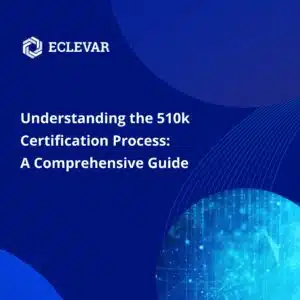What is the 510k Certification Process, and how can one gain a comprehensive understanding of it?
The Food and Drug Administration is responsible for the regulation of any firm that manufacture, repackage, relabel, and/or import medical devices in the United States. To be suited for the US market, FDA compliance must be followed throughout the entire process.
On the FDA pathway to commercialization, when a Premarket Approval is not required, you must submit a 510(k). This submission provides regulators with technical, performance, and safety information on your new medical device. Mainly, 510(k) submission is required for medium-risk medical devices.
Gain valuable insights into the 510k certification process, a crucial step for medical device market entry in the United States. Explore FDA approval procedures, requirements, and timelines, and discover the benefits of working alongside knowledgeable consultants.
What is the 510k?
The 510(k) submission aims to demonstrate that the device being marketed is safe, effective and substantially equivalent to a legally marketed device. The submitters are required to compare their device to one or more similar devices that are already on the market, providing evidence and support for their substantial equivalence claims.
The successful approval of a 510(k) submission depends on meeting several requirements, emphasizing the need for the expertise of a knowledgeable regulatory consultant. These consultants understand the expectations of the FDA and can meticulously prepare the required documentation from the initial stages, addressing all details, such as:
- Understanding of the device classification
- Proper documentation of the device design
- Selection of the most appropriate predicate device
- Demonstration of substantial equivalence
- Adequate labelling and instructions for use
- Adequate clinical testing
- Complete and accurate data
Having a competent regulatory consultant on board is crucial for navigating the complex landscape of 510(k) submissions. They possess a deep understanding of the FDA’s expectations and requirements, allowing them to guide the submission process effectively.
By meticulously preparing the documentation and addressing potential concerns or gaps, they increase the chances of a successful outcome. With expertise, they can help the manufacturer meet FDA’s expectations, ensuring that the 510(k) submission is comprehensive, accurate, and in line with the regulatory requirements.
What is the regulatory pathway for 510k clearance?
The 510(k) pathway provides a streamlined process for medical device manufacturers to obtain clearance from the FDA. By submitting a premarket notification, the manufacturer supplies essential information about the device’s intended use, design, and performance characteristics, comparing them to a similar device known as the “predicate device.”
The FDA carefully reviews the application to ensure that the device meets the equivalence criteria and functions as intended. Upon determining that the device is indeed substantially equivalent to an established device, the FDA issues a clearance letter to the manufacturer, granting permission to market the device in the United States.
It is important to note that clearance under the 510(k) pathway should not be confused with device approval. The FDA’s clearance signifies that the device meets the regulatory requirements for equivalence to an existing device in the market, rather than being an explicit endorsement of the device’s safety or effectiveness.
510(k) clearance
To be eligible for 510(k) clearance, a medical device must meet specific criteria:
- Device Risk Level — There are 3 levels regarding the risks a device can offer to patients. The first level devices are exempt from premarket submission, and, in some cases, Class II devices are also exempt.
- Device Type — For example, devices intended for use as a component of another device, custom devices, and devices intended for investigational use are not eligible for 510(k) clearance.
- Device History — Devices with history of being banned, withdrawn, restricted by the FDA, or previously rejected for 510(k) and PMA, cannot receive 510(k) clearance.
- Device Characteristics — Devices must comply with FDA standards for performance and safety.
- Substantial Equivalence — 510(k) clearance is granted to devices that work in equivalency to another already approved product, for they are known as “predicate devices”.
Types of 510(k)s
If your medical device is eligible under premarket notification criteria, there are three types of 510(k)s: Traditional, Abbreviated, and Special.
Traditional
The Traditional 510(k) pathway serves as the appropriate regulatory route for original medical devices that have not undergone prior clearance and do not need to go under the more rigorous Premarket Approval (PMA) process.
Additionally, this type of submission is employed when modifications have been made to a previously cleared device, but these changes do not meet the criteria for a Special 510(k).
To pursue the Traditional 510(k) pathway, it is crucial to establish clear links to predicate devices, demonstrating similarities in both the indications for use and technological characteristics of the device under review.
Abbreviated
The Abbreviated 510(k) program was established as a viable alternative to the traditional pathway for medical device submissions. This option was forged for when the submission is based on FDA guidance documents, showcasing compliance with specific controls applicable to the device type, or adherence to voluntary consensus standards.
By leveraging these existing resources, manufacturers can streamline the regulatory process, potentially reducing the burden of extensive testing and documentation requirements.
Special 510k pathway
The Special 510(k) pathway is specifically designed for manufacturers seeking to make changes to their own legally marketed predicate device that is already authorized for commercial distribution. This regulatory option provides a process for manufacturers to obtain clearance for modifications or enhancements to their existing devices.
When a 510(k) is and isn’t Required
A 510(k) is required when:
Introducing a device into commercial distribution (marketing) for the first time, unless exempt.
There is a change or modification to a legally marketed device and that change could significantly affect its safety or effectiveness.
The following are examples of when a 510(k) is not required:
- You sell unfinished devices to another firm for further processing or sell components to be used in the assembling of devices by other firms.
- Your device is not being marketed or commercially distributed.
- You distribute another firm’s domestically manufactured device.
- If you are a repackager or a relabeler and the existing labelling or condition of the device is not significantly changed. In this case the original manufacturer must already have the 510(k) clearance.
- Your device was legally in commercial distribution before May 28, 1976 and has not been significantly changed or modified in design, components, method of manufacture, or intended use.
- The device is made outside the U.S. and you are an importer of the foreign made medical device. In this case the original manufacturer must already have the 510(k) clearance.
- Your device is exempted from 510(k) by regulation (Class I and II devices found on Medical Device Exemptions 510(k) and GMP Requirements).
Eclevar – Partnering with the right CRO for 510k submission guidance
Counting on an expert CRO company to support you on the completion of the requirements asked by the FDA can save you time and money in entering the U.S. market. Contact us to know how we can help your device’s 510(k) clearance!

